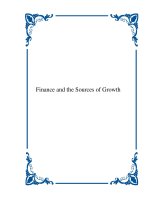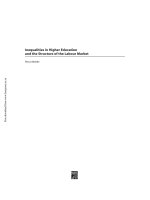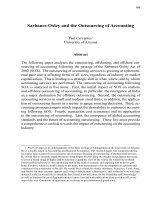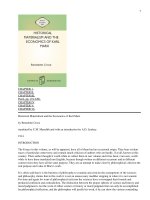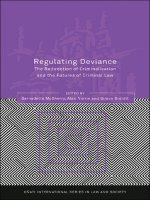No Trespassing Authorship, Intellectual Property Rights, and the Boundaries of Globalization docx
Bạn đang xem bản rút gọn của tài liệu. Xem và tải ngay bản đầy đủ của tài liệu tại đây (19.42 MB, 248 trang )
m
THE
GALT-COBLENTZ
BOOK
FUND
STANFORD
UNIVERSITYNO
TRESPASSING:
AUTHORSHIP,
INTELLECTUAL
PROPERTY
RIGHTS,
AND
THE
BOUNDARIES
OF GLOBALIZATION
In
this
scholarly
yet highly
accessible
work,
Eva
Hemmungs
Wirten
traces
three main themes
within
the
scope
of cultural
ownership:
au-
thorship
as
one of the basic features of
culture,
the use of intellec-
tual
property rights
as
a
privileged
instrument of
control,
and,
finally,
globalization
as a
precondition
under
which both
operate.
Underwrit-
ten
by rapid
technological
change
and
increased
global interdepend-
ence,
intellectual
property
rights
are
designed
to
protect
a
production
that is
no
longer
industrial,
but
informational.
No
Trespassing
tells the
story
of a
century
of
profound
change
in
cultural
ownership.
It
begins
with
late
nineteenth-century Europe,
ex-
ploring
cultural
ownership
in a number of
settings
across both
spatial
and
temporal
divides,
and concludes in
today's global, knowledge-
based
society. Hemmungs
Wirten takes an
interdisciplinary
and inter-
national
approach, using
a wide
array
of material from court cases to
novels for her
purposes.
From Victor
Hugo
and the 1886 Berne
Conven-
tion to the translation of Peter
H0eg's
bestseller Smilla's Sense
of
Snow,
Hemmungs
Wirten charts
a
history
of intellectual
property
rights
and
regulations.
She addresses
the
relationship
between author and transla-
tor,
looks
at
the
challenges
to intellectual
property by
the arrival of the
photocopier,
takes into account the media
conglomerate's
search for
content as a
key
asset since the
1960s,
and
considers
how a
Western
legal
framework interacts with
attempts
to
protect
traditional knowl-
edge
and folklore. No
Trespassing
is essential
reading
for
all
who care
about culture and the future
regulatory
structures of access to it.
(Studies
in
Book and Print
Culture)
EVA HEMMUNGS WIRTEN is an associate
professor
in
Comparative
Litera-
ture at
Uppsala University,
where she
also holds
a
Swedish Research
Council Postdoctoral
Fellowship
2002-2006.
HEMMUNGS
WIRTEN
No
Trespassing
Authorship,
Intellectual
Property
Rights,
and
the
Boundaries of
Globalization
UNIVERSITY OF
TORONTO PRESS
Toronto
Buffalo London
University
of Toronto
Press
Incorporated
2004
Toronto Buffalo London
Printed in
Canada
ISBN 0-8020-8835-X
(cloth)
ISBN
0-8020-8608-X
(paper)
Printed on acid-free
paper
National
Library
of Canada
Cataloguing
in Publication
Hemmungs
Wirten,
Eva
No
trespassing
:
authorship,
intellectual
property rights
and the
boundaries of
globalization
/
Eva
Hemmungs
Wirten.
(Studies
in
book and
culture)
Includes
bibliographical
references and index.
ISBN 0-8020-8835-X
(bound)
ISBN 0-8020-8608-X
(pbk.)
1. Intellectual
property.
2.
Authorship.
3.
Copyright.
I.
Title.
II. Series.
Z552.W47
2004 352.7'49 C2003-903964-1
University
of Toronto
Press
acknowledges
the financial assistance
to
its
publishing
program
of the Canada Council for the Arts
and the
Ontario
Arts
Council.
University
of Toronto
Press
acknowledges
the financial
support
for
its
publishing
activities of the Government of Canada
through
the
Book
Publishing
Industry Development Program
(BPIDP).
To
Minna,
Rebecca,
and
Aurora
-for
saving my day,
every
day
-
Preface
ix
Introduction:
The Pursuit of
Property
3
1
Wearing
the Parisian Hat:
Constructing
the International
Author
14
2
Inventing
F. David:
Author(ing)
Translation 38
3 The Death
of the
Author
and the
Killing
of Books:
Assault
By
Machine
57
4
How
Content
Became
King:
Economies
of Print
76
5
From
the 'Intellectual'
to the 'Cultural':
Can
There
Be
Property
with a 'Difference'?
100
6 Genies
in Bottles
and
Bottled-Up
Geniuses:
Two
Cases
of
Upset
Relatives
and a
Public Domain
125
Notes
149
References
191
Index
215
Diva
Revisited
Nothing
strikes one as
quite
so
embarrassingly
outdated as
relics of the
recently transpired.
Whether or
not it
was once
deemed the
height
of
fashion or
considered
an
outlandish
novelty by
its
contemporaries,
hip
grows
old with a
vengeance.
I
suspect
this is
why
re-experiencing
Jean-Jacques
Beineix's
film
Diva from
1981
makes the sensation
of wit-
nessing hypertrendy gone
charmingly hyperold
as
immediate as it is
powerful.
Beineix's ceuvre received
widespread
acclaim. Its
tongue-in-cheek
treatment of familiar
generic ingredients
instantly rejuvenated
the hard-
boiled tradition of American movie
classics and
film
noir.
Briefly,
the
story
revolves around a
young
postal
worker's infatuation with
opera
in
general
and the
singer Cynthia
Hawkins
-
played by
Wilhelmenia
Wiggins
Fernandez
-
in
particular.
He is so obsessed
by
her that he
secretly
records
one of her
performances,
even
though
she refuses her
permission
to
do so. No record of her voice
exists;
only
the
unduplicable
immediacy
of recital is on offer
-
irreplaceable, unique.
As the
story
progresses
and the
couple
become
romantically
involved,
things get
out
of hand. Intended for
personal
use
only,
the
pristine recording
is
aggressively
hunted down
by
Taiwanese
thugs representing
the not-
so-law-abiding
music
industry. Accidentally,
it crosses
paths
with a
surveillance
tape
disclosing
the
police
commissioner as head of
a
pros-
titution
ring,
and
suddenly
our
hero finds himself drawn into the
dark
underbelly
of
Paris,
pursued
from
all
quarters.
The soundtrack made
an
odd
international
hit
out
of the
aria
in
Catalani's
La
Wally
(1892),
and
came
accompanied by
a
scenography
perhaps
even more
innovative,
x
Preface
where
colours,
clothes,
and
interior
decorating
evoked the
stylish
1980s
to
come,
as
if
leaping
directly
out of one of the French much adored
bandes
dessinees.
Due to
its cult status for
a
generation
of which I was
definitely
a
part,
seeing
Diva in Paris almost
twenty years
after its
initial
release
pro-
duces
exactly
the
nostalgic feeling
of
deja
vu I had
come
to
expect.
Yet
the
film
also
triggers
a rather different kind of
recognition.
In
retro-
spect,
my enjoyment
is
not tied
only
to
lustful
digging
in
the archeo-
logical
bits
and
pieces
of
a
period's
form,
narratology,
and fashion. As
I
watch
the
account
of a
bootleg recording gone astray,
I
suddenly
realize
that
Diva
prophesied
one
of
the
more
pressing
concerns of
contempo-
rary
cultural life two
decades
later
-
namely
IPR,
or intellectual
prop-
erty rights.
Behind his extreme aesthetization of a
pretty straightforward
story,
Beineix
probed
a
territory
about to
undergo
a
dramatic
recon-
figuration:
he showed us how a new infrastructure of
ownership
made
possible by
a
fusion of
technology,
information, culture,
politics,
and
economics could look like.
There is no doubt
in
my
mind that the
late-night screening
of
Diva in
Paris
in
July
of 2000
helped
shape
this book into its
final
form.
When I
began my
work two
years
earlier,
I envisioned a
very
different end
product,
one
that
would be an account of the
changing
conditions
for
publishing
under
globalization.
I
knew
early
on that intellectual
prop-
erty rights
needed to be a
part
of that
story,
but somewhere
along
the
way
that summer
in
Paris I
shambled
not
only
on
Diva,
but
perhaps
more
importantly
on Victor
Hugo,
and
suddenly
the
perspective
of
one
chapter grew
into that of the entire
six.
It is a
great privilege
to be able to follow such new directions
and to
witness how a
project
in
some sense takes on
a
life of its
own.
'Going
with the flow'
would not have been
possible,
however,
if not for the
support
of a
number of
organizations
and individuals.
Through
its
committee
'Global Processes in a
European
Perspective,'
the Swedish
Council for
Planning
and
Coordination
of Research
(today
the Swedish
Research
Council)
set
things
in
motion
by offering
financial as
well as
moral
support
for the
project
in
1998-9.
A
generous
Knut and Alice
Wallenberg
Foundation
grant
for
recently graduated
female scholars
allowed me the
luxury
of time and travel when
I
needed
it the
most,
and a
postdoctoral
scholarship
from
the Swedish Foundation
for Inter-
Preface xi
national
Cooperation
in
Research and
Higher
Education
(STINT)
led to
an invaluable
stay
at the
University
of North
Carolina
at
Chapel
Hill
during
the
2001-2
academic
year.
For their
joint
invitation
leading up
to
that
visit,
I
am
deeply grateful
to
Professor Lawrence
Grossberg
at the
University
Program
in
Cultural
Studies
and
Professor
Joanne
Card
Marshall at the
School of
Information and
Library
Science.
Early
en-
couragement
from the
Department
of
Literature,
Uppsala
University,
where the
project
was
originally
conceived,
must be
recognized,
and I
acknowledge
both the
Centre for Cultural
Policy
Research and the
Swedish School of
Library
and
Information
Science,
Goteborg
Univer-
sity
and
the
University
College
of
Boras,
for
support expressed
in
many
different
ways
since 1999. In 2002 1
was awarded a
four-year postdoctoral
fellowship by
the Swedish Research
Council,
which facilitated the fin-
ishing
touches on the
book and above
all,
makes
it
possible
for me to
continue to
explore
a field that
fascinates me and that
holds so
many
challenging
avenues to
pursue.
During
the
past
four
years
I have had
the
opportunity
to
present
parts
of
my manuscript
at
various
seminars and
conferences
in
Sweden
as well as abroad. Rather than list all such
occasions,
I
extend a collec-
tive thanks to all who have
given
me the
opportunity
to vent a work
in
progress,
a
crucial,
yet
sometimes
overlooked,
element of academic
research.
Obviously,
I
have incurred
the
greatest
debt to those
persons
who have
carefully
read
and commented on the
manuscript
in
its
various
stages
of
completion
or
simply given
me
faith that
one
day
it
would materialize
into a
book,
particularly
Jonas
Ebbesson,
Anders
Frenander,
Jenny
Johannisson,
Carl
Josefsson,
Lars-Goran
Karlsson,
Dick
Kasperowski,
Claes
Lennartsson,
Jan
Nolin,
Annika
Olsson,
Henry
Olsson,
Veronica
Trepagny,
and Geir Vestheim.
My
husband Per
has,
as
always,
been
my
most
trusted reader.
Any
errors of
judgment, lapses
in
style
or
content,
should of course be
attributed to
me,
and
me alone.
As Peter
Stallybrass
and Allon White so
accurately
note:
'"place"
is
not
merely
a name but
something
like
a mode of
discursive
produc-
tion.'
1
I
am
acutely
aware of the fact
that
my
own
'discursive
produc-
tion' owes a tremendous
amount to
some
great places
where
I have
been fortunate to
spend
time
writing
this
book.
They
include
the
Bibliotheque
Nationale de
France,
site
Francois
Mitterand/Tolbiac,
and
the UNESCO
library
in
Paris;
the
Royal Library
in
Copenhagen;
and the
Stockholm
University Library
and the
Royal
Library
in Stockholm.
However,
it was the
impressive
resources
at the Walter
Royal
Davis
Library
and the
Kathrine
R. Everett
Law
Library
at the
University
of
xii
Preface
North Carolina at
Chapel
Hill,
that
really
made
all
the difference
to the
way
I
was able to conduct
my
research.
Finally,
credit where credit is most
profoundly
due.
I
dedicate this
book to
my
three
daughters,
whose
presence
in
my
life
makes
every-
thing
possible
to
begin
with.
NO TRESPASSING:
AUTHORSHIP,
INTELLECTUAL
PROPERTY
RIGHTS,
AND
THE
BOUNDARIES OF GLOBALIZATION
THE
PURSUIT
OF
PROPERTY
The
sequence
of events
depicted
in
the
pages
that
follow
unfolds
in
late
nineteenth-century
Europe
and is then
traced
up
to
today's
global,
knowledge-based
society.
As
I
explore
cultural
ownership
in a number
of
settings
across both
spatial
and
temporal
divides,
three
overlapping
interlocutory
spheres
serve as
backdrop
for
my
undertaking:
authorship
as one of
the basic
features of
culture;
intellectual
property rights
as
the
privileged
instrument
of control
exercised over the multifarious
resources
produced
by
the
first;
and
finally globalizat
ion
as the condition
under
which these
two
operate.
Before
concentrating
on
each
category
and their mutual
interconnec-
tions,
let us consider
some
of the reasons for
choosing print
culture to
frame the
overall concerns
of
this book.
An
undertaking
of this
kind
would
perhaps
be
better served
if
it
pivoted
around more Diva-like
topics,
such
as the
challenges
to the music
industry
a la
Napster.
Con-
sidering
that so
much of our
cultural
consumption
no
longer
is limited
to
the
offerings
of
culture,
why
is it
placed
centre
stage?
Ousted,
unseated,
dethroned
-
why
should
we care about
books,
magazines,
printed
material
at
all when
there are
any
number of other cultural
forms
poised
much
more
centrally
to
deal with these matters? Few
would
probably
disagree
with the
suggestion
that
if
there ever
were a
privileged
position
for
the
printed
word,
then
it
is
unquestionably
one under
fire.
Am
I
attempting
a
search-and-rescue
operation,
then,
looking
to reinstate
the
printed
word
in all its old
pomp
and
glory?
Or
is it
rather
the reverse
-
a
final act of
scooping
soil
on the coffin of
something
long
ready
for
burial?
Neither
option
sounds
particularly
desirable.
The
counterarguments
against
culture
are attractive
only
on
a
4
No
Trespassing
superficial
level. Even
if
we concede to the
sidelining
argument, print
culture allows
us,
perhaps
better than other media
forms,
to
historicize.
If
this
in turn needs
further
clarification,
we can
make a
case that it is
simply
because
of
the historical
legacy
of
culture;
because we
may
evaluate
and follow its
trajectories
through
time;
because
it is a
slow
medium
where
changes
and
transformations
brought
on
by,
for in-
stance,
new
technology may
work to
highlight
the conflicts and
clashes
of a
long
tradition
in
flux,
that
we are
capable
of
saying something
grounded
in the
experience
of
the
long
haul.
Print culture and
author-
ship
insist
on
being
understood
historically; using
this to our ad-
vantage
will,
in
turn,
add
to our
knowledge
of
globalization,
as
it
demonstrates the need to
put specific
events seen as
inherently
contem-
porary
into the
necessary perspectives
of time
and
place.
The same
arguments
that
can be launched
against
the
validity
of
culture can
be used
in
its
favour.
It
is
precisely
the historical
legacy, deeply
imbued with
questions
of
value,
originality,
hierarchization, imitation,
and
copying,
that makes
culture so
inviting
as
a
field of
inquiry.
Not
only
is this relevant to
publishing,
authors,
and
critics,
but
in
fact it
applies
to the entire field
of
print, including
those
who make
it
their business to
study
it
-
from
a
long-standing
preoccupation
with
textuality
in literature studies to the
material concerns of book
history.
These scholars
directly
or
indirectly
devote themselves
to issues
of immaterial
and
material
value,
and
hence
also moral and economical worth and
property.
1
To focus
on
culture rather than
any
other cultural form is not to
unduly
favour
it,
but
merely
to underscore that a certain nucleus must be
present
in
order for us to better understand the
present
from its
past.
Forms of
legal
control
in
culture
long predate
the arrival of the
'author' at what Michel Foucault
famously
terms
a
'privileged
moment
of indivualization/
2
Prior to such an
appearance
at the end of the
eight-
eenth
century, printers
and
publishers
were
generally
the first
copy-
right
owners
through
the
granting
of
privileges.
3
If
rights
and
traditions once mattered more
than
originality
and
personality,
then
the notion of the author as
a
self-contained,
unique
individual
whose works must be
judged
by
their intrinsic value alone is
a
new
invention concomitant with the advent of the author as
an
autonomous
legal subject.
The
penchant
of the time for
having
personal
Introduction
5
names as book titles
-
Pamela,
Clarissa,
Tom
Jones,
Tristram
Shandy
-
what
Mark Rose
labels 'the record of a
personality/
is but one
expression
of
how
authorship
and
legal
ownership began
to coexist.
4
Authorship
and
intellectual
property rights
are from the
very begin-
ning fundamentally paternalistic
and
gender-biased
discourses
that
continue
to
appoint
the
owner,
author,
and
proprietor
as
a
man,
a 'he.'
5
This strand of
thought
-
authorship expressed
in terms
of a
romantic,
individualistic
conception
of
original
creation influenced
by
and
sepa-
rated from
the
mundane
by
inspiration
that comes from within
(a
man)
-
is
widely accepted
as the
very
foundation of modern
intellectual
property
doctrine.
6
In order to understand the
underlying principles
behind modern
intellectual
property rights
we must
look to
history.
In
chapter
1,
Victor
Hugo's
opening speech
at
the
Congres
Litteraire International in
Paris
1878,
which would
subsequently
lead to the formation
of the Associa-
tion
Litteraire et
Artistique
Internationale
(ALAI)
and
indirectly
to the
first
multilateral
treaty
on
copyright,
the Berne
Convention for the
Protection of
Literary
and
Artistic Works
in
1886,
7
highlights
a number
of themes
that will resurface
during
the
following chapters.
The ration-
ale
behind the international control of intellectual
property
rights
that
Hugo
helped
orchestrate
is a
tremendously
important
feature
to
ad-
dress because
it
provides
a structure
by
which we can understand the
emerging
internationalization
taking place
more
than a
century ago
as
a
thing apart
from,
yet
also
reminiscent
of,
what we
will
encounter
in
globalization.
A
major
incentive
behind the construction
of these
early
international
conventions
was the
question
of
translation.
By taking
a
closer
look,
in
chapter
2,
at the two
English-language
versions
of Peter
H0eg's
bestseller
Fr0ken Smillas
fornemmelse
for
sne
(1992),
I
will
highlight
two
major
itineraries. The
first relates to the
question
of where the
limits of author-
ship
are drawn
and to whom
the text
belongs,
translator or author or
both. The second
addresses
the issue of intellectual
property rights
as
an instrument of
cultural
imperialism,
whether French
at the end of the
nineteenth
century
or
Anglo-American
at the
beginning
of the
twenty-
first.
Yet,
it is
important
to
remember
that as
we look to the author for
guidance
we are
dealing
not
only
with an
individual,
a
person.
To be
more
precise,
authorship
should
be
interpreted, again
drawing
on
Foucault,
as
a function
profoundly
'transdiscursive'
8
in
nature,
sup-
ple
enough
to
carry
over
into
computer
programming,
software
pro-
duction,
genetic
and
/or
agricultural
research,
including
individuals,
6
No
Trespassing
corporations,
collectives,
even
perhaps
residing
in
prehuman
creator
ancestors.
9
Clearly
this function
acts as an
interpretative
instrument
allowing
us
to
probe
the
many contradictory
tenets of intellectual
property rights
of
today,
but it
does
not limit the
possible
uses
and
strategies
to which
authorship
can be
deployed.
What
is
important
in the end
is therefore
not so
much the identification of
authorship,
but the
varying
and
some-
times
conflicting
uses to which
it
is
being
put.
The
strength
of
author-
ship
resides thus
in
its
flexibility,
its
capacity
to be used for different
ends
by
different
agents.
One
thing
is certain: the
relationships
ex-
plored
in
the
following chapters
will
routinely pit
cultural and
financial
investments
against
one another. Our
object
of
shady
can be
Victor
Hugo
or the infrastructures of information
technology,
but someone
is
always claiming rightful ownership
of the
property
in
question,
be it
printers,
booksellers, authors, readers,
or TransNational Media-
Corporations
(TNMCs).
In
chapter
3,
the book moves forward
to
explore
the critical
feature of
technology
as an
agent
of
change
in
reference to intellectual
property,
using
the
copier
as a case
study. Represented by
Chester
Carlson's
invention
xerography
and
the machine
itself,
this is not such a far-
fetched
choice as
it
might initially appear. Using
the
copier
to illustrate
how an
instrument for
reproduction
functions
to
decentre
the notion of
text,
reproduction,
and
copy
enables
interesting
correspondences
be-
tween
technological
innovation,
textual
categorization,
and
regulatory
frameworks.
Under the influx of
globalization,
intellectual
property rights
takes
on a new
urgency.
As a
consequence, power
in
this field is
assigned
to
those who
have the
ability
to
deny
access to certain
resources,
or who
may
fence
in
specific types
of valuable
knowledge.
10
In
chapter
4,
1
turn
my
attention to the
relationship
between
conglomeratization,
content,
and
convergence
in
order
to
describe the
increasingly
important
eco-
nomic
motives behind intellectual
property rights, arguing
that content
ownership
and
protection
must be seen as one
of the incentives behind
the radical
restructuring
of
publishing
since the 1960s.
Why
not
then,
in
light
of the
subject
matter
and
its
historical
legacy,
use the
more
commonly
known term
copyright
rather
than intellectual
property
rights
to
denote
the
regulatory regime
that
safeguards
con-
tent?
There are
two
main
reasons.
Currently
the
scope
of the
Agreement
on
Trade-Related
Aspects
of Intellectual
Property Rights
(TRIPS),
which
together
with
the Berne Convention
represents
key
international texts
Introduction 7
on
intellectual
property
rights,
includes
copyright
and related
rights,
trademarks,
geographical
indications,
industrial
designs, patents,
layout designs (topographies
of
integrated
circuits),
protection
of un-
disclosed
information,
and
control
of
anticompetitive practices
in
con-
tractual licences.
By
speaking
of
intellectual
property rights
we
automatically
include
copyright,
and
while
copyright indisputably
has
far more
in
common with
culture
than,
say,
geographical
indica-
tions
and
integrated
circuits,
what
would seem an
apparently
obvious
choice
of
words can still be
debated.
For one
thing,
while
the differ-
ences
between the
French Droit
d'auteur
-
Urheberrecht
in
German,
Upphovsmannaratt
in
Swedish,
Diritto di
autore
in
Italian
-
on one
side,
and
the
Anglo-American
Copyright,
on the
other,
should not be
exagger-
ated,
they
are often
seen
as
two
very
different
legal
stances vis-a-vis
intellectual
property.
11
As
they
stem from
the traditions of civil law and
common law
respectively,
Paul Edward
Geller instead
speaks
of author-
ship
norms and market
place
norms to
stress
the
differences
in
approach.
12
For
example,
the
French
and
continental tradition
recognizes
the moral
rights
of the
author,
13
and vests
them almost
exclusively
in flesh-and-
blood
individuals;
the common law
tradition,
on the
other
hand,
allows
legal
entities to act as authors under the so-called work for hire
princi-
ple.
14
Far
from mere
judicial
cosmetics,
the
implications
of
droit d'auteur
and
copyright
on
the international
agenda
of intellectual
property rights
as well as
being epistemological
tools used to
decipher
the events
that I
discuss
in
this book must somehow
be contended with. On
balance,
the
relationship
is better
perceived
as
dialectical,
providing
a useful frame
within which the various
battles
regarding
intellectual
property may
be
concretized.
15
As
a
consequence,
intellectual
property rights
-
propriete
intellectuelle in French
-
denoting
the
legal rights
which result
from
intellectual
activity
in
the
industrial,
scientific,
literary,
and artistic
fields,
simply
represents
a more neutral choice
of
terminology.
16
Sec-
ondly,
and as
will
become clearer
towards the
end of the
book,
many
of
the
current tendencies
in
intellectual
property rights
must
be
rethought
outside
the realm of traditional
copyright.
The conflicts
that arise from
the clash
between a non-
Western view of
culture
and
the Western
author-based
romantic ideal is
fertile
ground
for a number of
questions
regarding
the limits
and
possibilities
of
intellectual
property
rights.
That
disagreements
ensue
when
you
seek
to
protect
and
preserve
completely
different assets
from
the ones held
by
the TNMCs is
apparent
if we consider
the efforts
of,
among
others,
the United
Nation's
specialized
agency
World
Intellectual
Property
8 No
Trespassing
Organization
(WIPO)
to secure folklore and traditional
knowledge
(TK)
within the framework
of intellectual
property rights
and
TRIPS. The
international
community
here
faces one of its most
provocative
chal-
lenges
to
date,
which leads me to look more
closely
at the
possibility
of
'cultural'
property rights
in
chapter
5.
One of the basic
premises
of intellectual
property protection
concerns
the
relationship
between
the immaterial and
the material. Article
2
of
the
Berne Convention
does not
make fixation
mandatory,
but it is
generally
the case
that
expressions
and
not ideas as such are
protected,
and thus some sort of material
conditioning
becomes
necessary.
17
While
it
would
seem that
my emphasis
on the immaterial as the main asset
sought
for
protection
is
problematic
because of this
proviso,
this is
only
one
of several inconsistencies
that
earmark intellectual
property
rights.
Take music: not
only
records but also live
performances
are
produced,
something
that makes it
fundamentally
different from the function of
book
/text,
which is still consumed
mostly individually
and
in
silence.
'Although
material
objects
(records,
compact
discs,
cassettes)
are
in-
deed
traded/
Steve
Jones
argues
when,
in a
highly illuminating way,
he
illustrates the
rapport
between
the material and
the immaterial
in
re-
spect
to music
and intellectual
property rights,
'what
gives
those com-
modities value is the abstracted
object
of
copyright
-
namely
music.'
18
Paraphrasing
Jones,
content is
the
abstracted
object
of
copyright
in
this
book.
In
the
end,
both
the term intellectual
property
and
copyright
fall
short of
rendering
this
important
feature,
which is more
accurately
captured by
the Swedish term used for intellectual
property rights:
Immaterialratt
(law
of the immaterial
/intangible).
We can deem intellectual
property rights
the successful
-
or
failed,
depending
on our
position
-
administration of a set of
contradictory
tenets of which the correlation between the immaterial and the material
represents only
one
part.
A
subset of other
conflicting
facets is the
relationship
between
private protection
and
public good;
the
problem-
atic balance between
rights
and
obligations;
the
ambiguities surfacing
as free trade treaties are elaborated on the basis of
strengthening
mo-
nopolies
in
the name of
global
free
trade;
and the
question
of
piracy
or
copying
infringements
as either
attempts
to undermine
a
nationally
important
industry
or
simply
as a form of
flattery.
19
In
the final
chapter,
I will
use
two sets of
upset
relatives,
the estate of
Margaret
Mitchell
and a
great-great
grandson
of Victor
Hugo
-
the first
of
whom were
engaged
in
litigation against
the 2001
publication
of
Alice Randall's The Wind Done
Gone,
a rewrite of Gone
With
the
Wind;
Introduction 9
and the second
stirring
a
debate in
France over the
publication,
also
in
2001,
of Cosette
ou le
temps
des
illusions,
a
follow-up
to Les Miserables
-
to
recapitulate
these
conflicts
in
respect
to one of the most
important
features Victor
Hugo
raised in
his 1878
speech:
'le domaine
public.'
The third and final
sphere
underpinning
this
investigation
is
globaliza-
tion: the
time-space
continuum
enveloping authorship
and intellectual
property
rights. Despite
the
many options
that
come to
mind
when we
set out to define its
characteristics,
one
in
particular
overshadows the
alternatives
on where
to
begin
peeling
its
layers.
It
concerns the
impor-
tance of
spatiality. Why
is
this notion
of
spatiality
so central
to
globaliza-
tion? The most obvious answer
is that as we think
of what we mean
when we
talk
about
globalization,
we refer to various
formations
that
may
or
may
not be
absolutely
new to us but
which are made
possible
by
a
rapidity, intensity,
and
scope
of
mind-boggling proportions.
If
pushed
to be more
specific,
we will no
doubt
exemplify
those with
significant
increases
in
flows of
capital,
culture,
people,
and
labour,
now
organized,
maintained,
and
developed independent
of nation-
state
logic
and
in
large part
due to
sophisticated technology.
And
as
they
take
shape
and come into
focus,
we
will
perhaps
concur that all of
these
configurations
demonstrate new kinds of
spatial
networks
and
interdependencies.
We can
view it as a buzzword or
agree
that
it
is the cliche of
our
times,
20
but
globalization
undeniably
denotes
a
very specific
temporal
experience
in
which increased
migration, mobility,
and transborder
flows of
money
and culture are
commonplace.
We are
presented
with
events that have substantial
spatial
connotations,
where
questions of
ex-
tended
space,
spatiality
and
place
are
foregrounded.
21
In
trying
to come
to
terms with the
repercussions
of these
processes,
we
are offered the
possibility
of
thinking
differently
about the world. Hence
the
underlying
assumption
of this
study, equally
concerned
then
with the more meas-
urable and
tangible
elements of
globalization,
as
with their
potential
to
create
a theoretical
matrix,
a
space
made
up by
the
importance
of
places.
22
Working
with
globalization
in
this
context means
acknowledging
that it
actually
denotes
something very
real while
also
remembering
that
it
is
a
powerful
epistemological
representation
that
impinges
on
the
way
in which we
have come
to understand
others
and ourselves.
